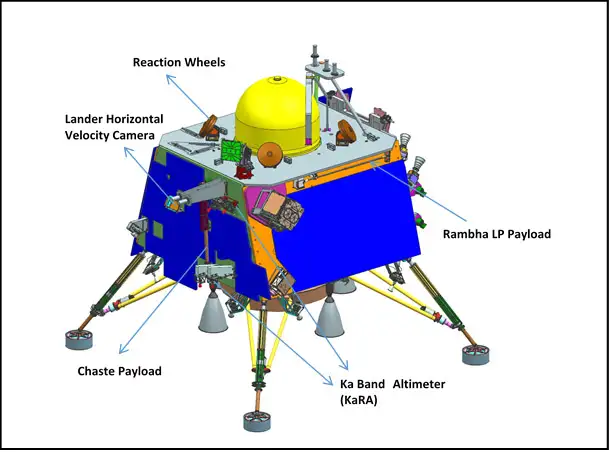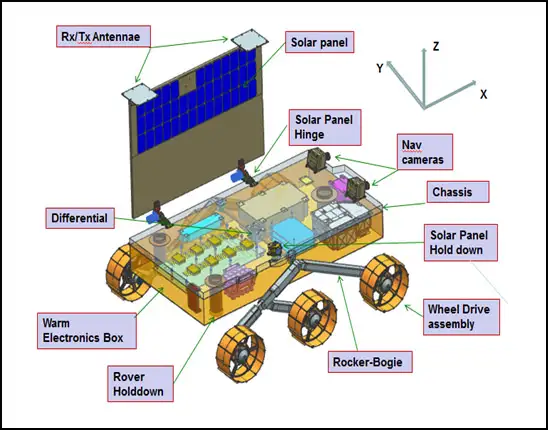Chandrayaan-3: India’s second shot at landing on the Moon
- Karthik Naren
- Jul 13, 2023
- 6 min read
Updated: Jul 14, 2023
ISRO aims to make India the 4th country to land successfully on the moon. This ambitious venture is designed to demonstrate a soft landing and roving in the lunar south pole region.

India's much-anticipated lunar mission is poised to propel the nation's space exploration endeavors to new heights. Set to launch from the Satish Dhawan Space Centre-SHAR space center in Sriharikota, the automatic interplanetary station will embark on its journey using the powerful Launch Vehicle Mark-III (LVM3) rocket M4. The Indian Space Research Organization (ISRO) is all set to make history once again as they aim to accomplish their first-ever moon landing.

Scheduled for lift-off on July 14th at 14:35:17 IST (09:05:17 UTC), Chandrayaan-3 will mark the third Indian mission to the Moon and the fourth operational mission of the LVM3 rocket.
The spacecraft will be placed in an initial orbit of 170 by 36,500 km, to then perform five maneuvers (one ascent at perigee, four at apogee); the translunar injection (TLI) is due on July 31st. The arrival to the Moon will be on August 5 with entry into an elliptical lunar orbit and further descent to a circular orbit with an altitude of 100 km.
ISRO plans to keep the names of the lander and rover used on Chandrayaan-2 for their equivalents on Chandrayaan-3,” space agency president S. Somanath told The Hindu newspaper. This means that the lunar rover will be named 'Vikram' (in honor of Vikram Sarabhai, the father of the Indian space program) and the rover, 'Pragyan'.

Chandrayaan-3 Mission & Spacecraft specifications.
Chandrayaan-3 is made up of three modules (Propulsion Module, Lander Module with a miniature lunar rover) and has secondary payloads specifically for the lander.
The mission is anticipated to have a lifespan of approximately one lunar day, which translates to around 14 Earth days. The prime landing site, carefully selected, spans an area of 4 km x 2.4 km, located at coordinates 69.367621°S and 32.348126°E. near to the Manzinus U crater in the south pole region.
Chandrayaan-3 is set to land on the lunar surface on August 23 at 5:47 PM IST (12:17 UTC) according to TOI sources. If successful, it will make India the fourth country to achieve a soft landing on the moon. Building on the lessons learned from Chandrayaan-2, ISRO has implemented several changes to ensure a safe landing. The mission holds great significance for India's space exploration endeavors and scientific achievements.

The Lander Module is equipped with a wide array of sensors, including the Laser Inertial Referencing and Accelerometer Package (LIRAP), Ka-Band Altimeter (KaRA), Lander Position Detection Camera (LPDC), Lander Hazard Detection & Avoidance Camera (LHDAC), Laser Altimeter (LASA), Laser Doppler Velocimeter (LDV), Lander Horizontal Velocity Camera (LHVC), Micro-Star sensor, Inclinometer & Touchdown sensors, and four Reaction wheels.
To ensure a safe touchdown, the Lander's actuators consist of four Reaction wheels, with 10 Nms and 0.1 Nm capabilities. The Lander is equipped with a Bi-Propellant Propulsion System, comprising four 800 N Throttleable engines and eight 58 N Throttleable engines, along with Throttleable Engine Control Electronics.

As the highly-anticipated touchdown approaches, specific touchdown specifications have been established. The Lander's vertical velocity is expected to be less than or equal to 2 m/sec, horizontal velocity less than or equal to 0.5 m/sec, and the slope limited to a maximum of 12 degrees. These parameters ensure a controlled and precise landing.
Chandrayaan-3's Lander Module and Rover are equipped with scientific payloads that have specific objectives and contribute to advancing our understanding of the Moon. Here are the details of the planned payloads:
Lander Payloads:

1. Radio Anatomy of Moon Bound Hypersensitive ionosphere and Atmosphere (RAMBHA) - Langmuir probe (LP): The objective of RAMBHA is to measure the near-surface plasma density, including ions and electrons, and monitor its changes over time. This data helps in studying the ionosphere and atmosphere of the Moon.
2. Chandra's Surface Thermo physical Experiment (ChaSTE): ChaSTE aims to conduct measurements of the thermal properties of the lunar surface in the polar region. By studying the temperature variations and conductivity, scientists can gain insights into the thermal behavior of the Moon's surface.
3. Instrument for Lunar Seismic Activity (ILSA): ILSA's goal is to measure seismic activity around the landing site and analyze the structure of the lunar crust and mantle. This helps in understanding the Moon's geology and studying lunar quakes or seismic events.
4. LASER Retroreflector Array (LRA): The passive experiment from NASA that provides valuable data for understanding the dynamics of the Moon's system. It helps in studying the reflection and scattering of laser beams, contributing to research on the Moon's rotational dynamics and orbital variations.

Rover Payloads:
1. LASER Induced Breakdown Spectroscope (LIBS): LIBS performs qualitative and quantitative elemental analysis of the lunar surface. By studying the chemical composition and inferring mineralogical information, LIBS enhances our understanding of the lunar surface and its geological characteristics.
2. Alpha Particle X-ray Spectrometer (APXS): APXS aims to determine the elemental composition of lunar soil and rocks near the landing site. It specifically analyzes elements such as magnesium, aluminum, silicon, potassium, calcium, titanium, and iron. These measurements provide valuable insights into the composition and geological history of the Moon.
These scientific payloads on Chandrayaan-3 play a crucial role in expanding our knowledge of the Moon's environment, geology, elemental composition, and potential habitability.
Propulsion Module:
The Propulsion Module serves the crucial role of carrying the Lander from launch injection to lunar orbit, while the Lander Module provides a safe haven for the Rover inside. The total mass of the mission stands at 3900 kg, with the Propulsion Module weighing 2148 kg and the Lander Module, including the 26 kg Rover, weighing 1752 kg.

The payload on the Propulsion Module, SHAPE (Spectro-polarimetry of HAbitable Planet Earth): focuses on spectro-polarimetry for studying Earth-like exoplanets. By observing the reflected light from smaller planets, SHAPE aims to contribute to the identification and characterization of habitable planets or planets that may harbor signs of life.

Power generation: The Solar Panels on Propulsion Module generate 758 W of power, while the Lander Module produces 738W with Bias. The Rover, on the other hand, generates 50W of power, enabling it to fulfill its scientific objectives.
Communications: The Propulsion Module establishes communication with IDSN (Indian Deep Space Network), while the Lander Module maintains communication with IDSN and the Rover. As an additional contingency link, Chandrayaan-2 Orbiter is also planned to be utilized.
Lessons Learned and Improvements:
Chandrayaan-3 incorporates valuable lessons learned from the Chandrayaan-2 mission. ISRO has made significant improvements to hardware, software, sensors, and algorithms to prevent failure. The Vikram lander, crucial for achieving scientific objectives, has undergone enhancements such as strengthened legs, increased velocity threshold, and additional sensors for redundancy. The propulsion module replaces the orbiter and carries one payload instead of eight. The lander carries more fuel, additional solar panels, and updated software for real-time error correction. The landing site has also been expanded. These improvements reflect ISRO's commitment to overcoming past challenges and ensuring the success of Chandrayaan-3's mission.
A new step for the Asian power in space
The head of the ISRO, S. Somnath, confirmed on Wednesday the 12th that the countdown for the mission was scheduled to start at 13:00 today Thursday. The countdown will be 25 hours and 30 minutes until launch. According to official media: “At 2.35 pm on 14 July India's space program will mark an era with the lift-off of Chandrayaan 3 from Satish Dhawan Space Centre, Sriharikota. The country's third mission to the Moon will carry a landing module (Vikram), a rover (Pragyaan), and a propulsion module. The integrated rover will reach a 100-kilometer circular polar orbit in the third week of August, and then the lander will slowly descend to the lunar surface, making India the first nation to land in unexplored high-latitude regions of the Moon.
Around August 23, we expect to land on the lunar surface. The mission builds on the excellent work done by Chandrayan 2, which placed an orbiter in lunar orbit that continues to transmit data.
In 2019, the Chandrayaan-2 lunar lander worked very well for more than 90% of its trajectory, but deviated from course in the last kilometer of the descent, suffering a breakdown. Since then, the landing technology, which was first developed and applied four years ago, has been improved. Landing on the surface of another celestial body is a difficult game; it is an autonomous process in which no command or control is given. For landing, many sensors must work together. For example, an optical camera determines exactly where the craft is, a laser or radio system tells you how far you are from the surface, and a set of sensors constantly calculates horizontal and vertical speeds. This information is fed in real-time to the on-board computer that manages navigation, communications, command and control (GNC) to trigger the engines, in which direction and with what power.
With Chandrayaan-3, India aims to cement its position as a leading player in lunar exploration and showcase its technological prowess on the global stage. As the launch countdown commences, all eyes are on this remarkable mission, eagerly anticipating the groundbreaking discoveries and achievements that lie ahead.





































Comments